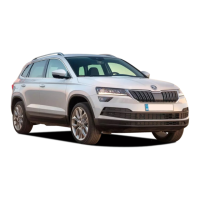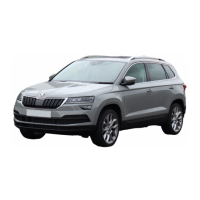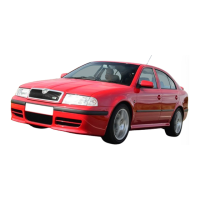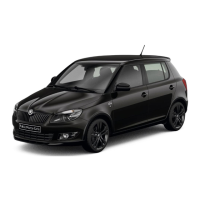Opening
›
Turn the regulator
B
» pav. 160 downwards.
›
Turn the regulator
C
» pav. 161 upwards.
Closing
›
Turn the regulator
B
» pav. 160 downwards.
›
Turn the regulator
C
» pav. 161 downwards.
Depending on the setting of the air distribution, the air stream comes out of
the following air vents.
Set the direction of the air
outlet
Ventiliacinės angos » pav. 160 ir » pav. 161
1, 2, 4
1, 2, 4, 5, 7
3, 4, 6
4, 5, 7
3, 4, 5, 6, 7
ATSARGIAI
Do not cover the air vents - the air distribution could be compromised.
Auxiliary heating (auxiliary heating and ventilation)
Įvadas į temą
The auxiliary heating heats the vehicle interior as well as the engine. For hea-
ting, fuel is consumed from the fuel tank.
The auxiliary ventilation enables fresh air to flow into the vehicle interior with
the engine switched off, whereby the interior temperature is effectively dec-
reased (e.g. with the vehicle parked in the sun).
The auxiliary heating (auxiliary heating and ventilation) (referred to just as auxi-
liary heating in the following) ensures the heating / ventilation depending on
the setting of the air conditioning and the air outlet vents before switching off
the ignition.
DĖMESIO
■
The auxiliary heating must never be operated in closed rooms (e.g. gara-
ges) – risk of poisoning!
■
The auxiliary heating must not be allowed to run during refuelling – risk of
fire.
■
The exhaust pipe of the auxiliary heating is located on the underside of
the vehicle. If you want to use the auxiliary heating, do not park the car in
places where the exhaust fumes can come into contact with flammable
materials such as dry grass, undergrowth, leaves, spilled fuel etc. - risk of
fire.
ATSARGIAI
The air inlet in front of the windscreen must be free (e.g. of ice, snow or lea-
ves) to ensure that the auxiliary heating operates properly.
Nurodymas
■
The auxiliary heating switches the blower on, if it has achieved a coolant tem-
perature of approx. 50 °C.
■
In the engine compartment, water vapour may form during the operation of
the heater.
120
Operation

